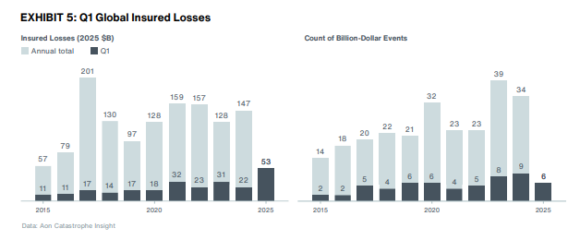Global natural catastrophes had an insured price tag of more than $53 billion during the first quarter of 2025 – claims driven by California’s wildfires of approximately $38 billion, or 71% of total insured losses across the globe, according to Aon’s Q1 Global Catastrophe Recap – April 2025.
Insured losses during the quarter ($53 billion) were significantly higher than the 21st century Q1 average of $17 billion and represented the second-highest total on record after Q1 2011.
“At least six events, all of which occurred in the United States, surpassed $1 billion in insured losses. With an additional disaster activity expected in the rest of the year, 2025 may become another costly year for insurers,” Aon said.

Q1 global economic losses were preliminarily estimated at $83 billion (Q1 2024: $54 billion), or 36% higher than the long-term 21st century Q1 average of $61 billion, Aon said, noting that economic losses (which include the insurance price tag) were driven by the California wildfires and other billion-dollar events, such as multiple severe convective storm (SCS) outbreaks across the U.S., and the earthquakes in Myanmar and China.
U.S. economic losses accounted for around $71 billion of the economic loss total, their highest since 1994 (Northridge Earthquake) and significantly above the Q1 average since 2000 ($12 billion). By contrast, Q1 economic losses in all other regions were below their long-term Q1 averages.

The figures point to an insurance protection gap of 36%, the lowest Q1 value since 1990 (47%), which Aon attributed to high insurance penetration in the U.S., where most of the losses occurred. (The insurance protection gap is the difference between total economic losses and the amount covered by insurers).


